For the citizens of Russia’s far-flung regions, filming it all on their phones, it scarcely seemed believable.
Life in the villages of deepest Siberia or Russia’s Arctic north felt a world away from the front lines of their country’s war with Ukraine.
Yet suddenly, as they went about the Sunday business, the war unmistakably and dramatically arrived at their doorsteps. From the roof panels of nondescript container lorries parked in quiet rural lay-bys, drone after buzzing drone rose nonchalantly into the sky before hurling itself at nearby airbases housing some of Russia’s most prized military assets.
A hardy few onlookers scrambled onto the lorries, vainly trying to stop the tiny drones from completing their kamikaze missions. Most stood gaping as explosions echoed across the tundra.
Five airfields came under attack on Sunday as Ukraine launched Operation Spider’s Web, the most daring mission it has mounted on Russian soil in more than three years of war. Its target: Russia’s strategic bomber fleet, long considered beyond Kyiv’s reach.
As plumes of smoke rose over the Olenya and Belaya bases and footage emerged of £75-million supersonic jets reduced to fireballs by drones costing only few thousand pounds, the scale of the Kremlin’s miscalculation became clear.
According to Ukrainian officials, as many as 40 of Russia’s most expensive and sophisticated bombers – perhaps a third of Russia’s entire strategic bomber fleet – were eliminated in the space of a few hours.
The attacks came at a critical juncture, just hours before Russian and Ukrainian delegates were due to meet again in Istanbul. With Donald Trump’s peace initiative already teetering flimsily, the talks have taken on a new complexion.
Credit: Telegram / russianocontext
Though the timing was most likely calculated to send a message, Ukrainian officials say planning on the operation began 18 months earlier.
The final stage began a few weeks ago, when dozens of first-person view drones were smuggled into Russia under the supervision of Ukraine’s domestic intelligence agency, the SBU.
Russia’s bombers had always been the target but adjustments were required after Moscow moved much of its strategic air fleet deeper inland to shield it from strikes.
The drones were hidden in modified containers fitted inside commercial hauliers whose roof panels retracted at the push of a remote-control button.
By all accounts, the drivers had no idea what cargo they were carrying.
Residents near the Olenya base in Russia’s far north – one of the targets – described watching as a panicked driver ran in circles as drones launched, one after another, from the back of his lorry.
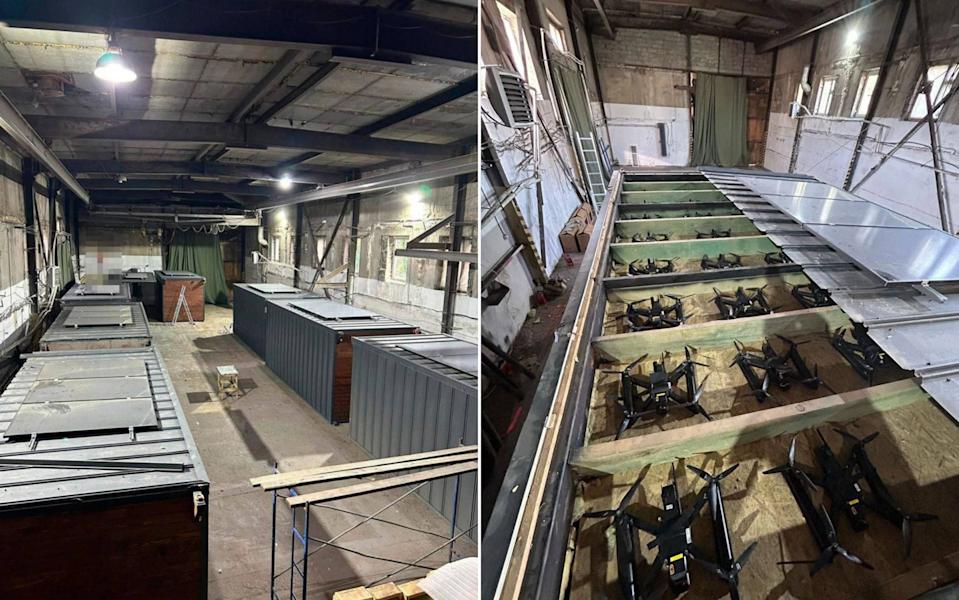
The drones concealed inside shipping containers
He later told police that he had been instructed to park his vehicle in a lay-by near the town of Olenegorsk where somebody would meet him.
Not all of the lorries made it to their destinations, with videos showing at least two “self-destructing” en route.
It was not the first time trucks had been used in the war. In 2020, a lorry carrying explosives was remotely detonated during an attack on the Kerch Bridge connecting Crimea to the Russian mainland.
But this was rather more sophisticated. Reports suggest the drones had been trained using artificial intelligence to strike aircraft at their weakest points. The attack came so swiftly no Russian airman is believed to have reached the relative safety of the skies.
Just weeks earlier, Russia had relocated many of its strategic bombers to bases deeper inside its territory. Olenya, located within the Arctic Circle, is more than 1,000 miles from the Ukrainian border; Belaya, in Siberia, 2,500 miles. Until Sunday Ukraine had never struck more than 1,000 miles inside Russia.
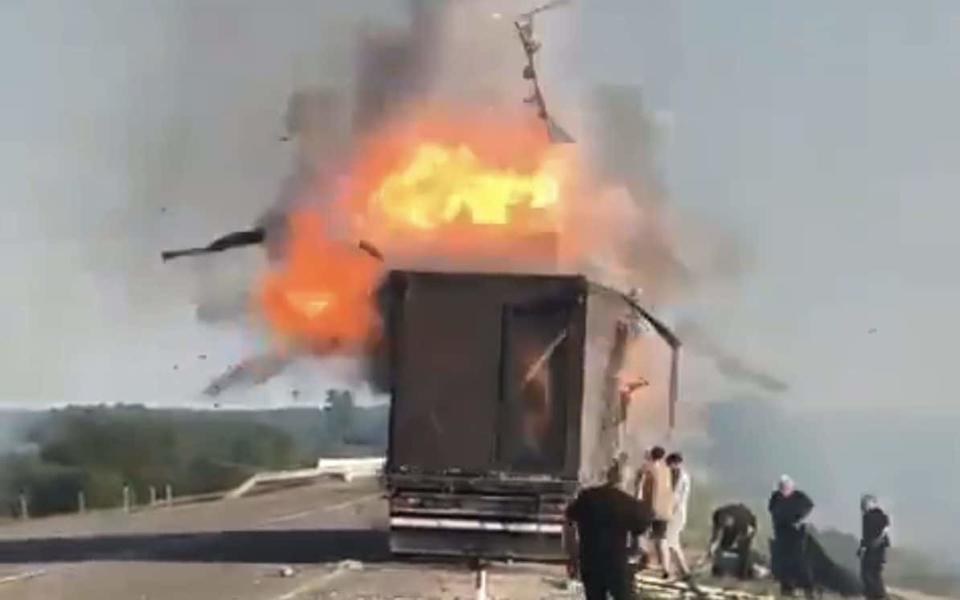
A Russian man enters one of Ukraine’s drone trucks, and moments later a self-destruction mechanism ignites and the vehicle explodes
The aircraft based at Olenya and Belaya were among the jewels of the Russian Air Force: the Tu-95 “Bear”, a long-range bomber capable of carrying nuclear or conventional warheads; the Tu-160 “Blackjack”, the largest combat aircraft in the world, and the Tu-22M3 “Backfire”, a supersonic workhorse.
The Russians had not counted on Ukraine’s Mossad-like ingenuity – or its desperation to retaliate against the bombers that had rained destruction on its cities.
Operation Spider’s Web did not rely on long-range drones or missiles, but on small, hand-held FPV drones – relatively simple devices that have proved devastating on the battlefield.
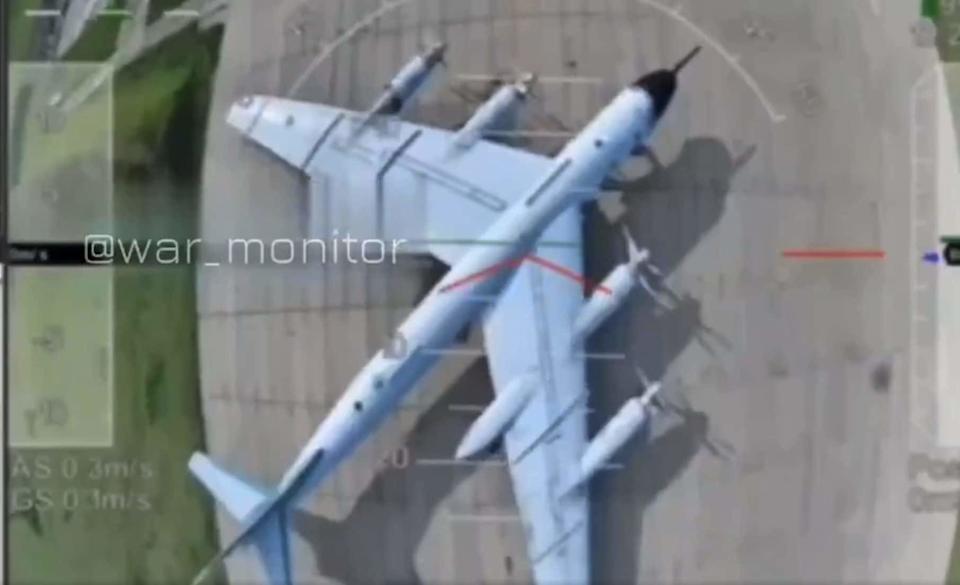
Ukrainian drone uses AI to pick the weakest spot of a Russian strategic bomber and then destroys it
Russian military bloggers were quick to liken it to the Japanese surprise attack on Pearl Harbour in 1941. An exaggeration, certainly – yet in terms of chutzpah, scope and possibly damage, the operation marked an unprecedented moment in the war.
Ukraine’s security services had “set a new bar of skill in conducting large-scale combat operations on enemy territory,” Iryna Vereshchuk, deputy head of Ukraine’s presidential office, wrote on Telegram. “This is not a knockout, but a very serious knockdown for the enemy.”
According to Ukrainian officials, as many as 40 of Russia’s most expensive and sophisticated bombers were eliminated in the space of a few hours.
That claim awaits independent verification, yet whatever the finally tally, Ukraine has inflicted a humiliating blow on Russia – and sent a powerful signal to its Western allies.
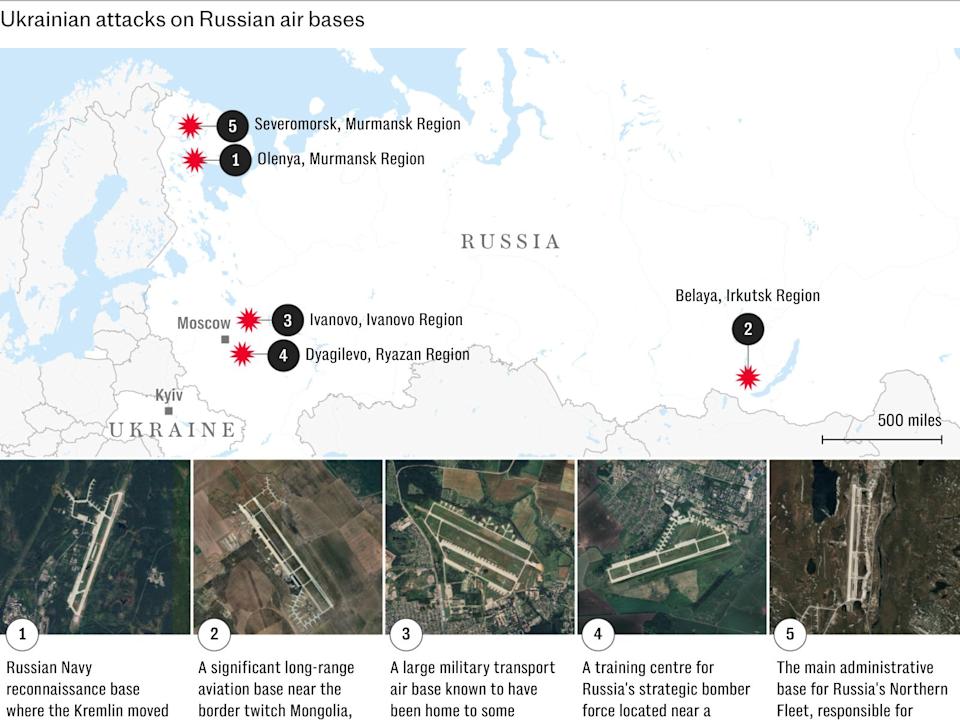
0206 Ukrainian attacks on Russian air bases
In the days leading up to the strike, Ukraine’s cities had endured some of the most intense Russian bombardment of the war. Dozens had died, children among them. The Kremlin has shown no sign of relenting and is likely to take its vengeance in the coming days.
As his envoys prepared for a second round of negotiations in Istanbul, Vladimir Putin seemed determined to project military dominance. Confident of victory, he ignored requests Kyiv’s requests to share his peace terms in advance.
But hours before the talks began, Volodymyr Zelensky, the Ukrainian leader, delivered a pointed message of his own.
There had been coordinated attacks on Russian airfields before. On August 13 last year, Ukraine targeted four airbases in Kursk, Voronezh and Nizhny Novgorod. But all were within a few hundred miles of the Ukrainian border.
Operation Spider’s Web was conceived on a much grander scale.
The night before the strike, Ukraine endured perhaps the heaviest aerial support of a bloody week. Kyiv reported that 472 drones and seven ballistic and cruise missiles had struck targets across the country. Twelve Ukrainian soldiers died in a separate attack on a training base on Sunday.
But revenge would follow. Early that day, two transport bridges in the Russian regions of Bryansk and Kursk were blown up as trains passed, killing seven people. Russians officials blamed Ukraine.
Yet those attacks were just a prelude. The main attack came hours later, with far greater effect.
Among the planes destroyed, Ukrainian intelligence said, was an A-50 “Mainstay”, a £230 million Airborne Early Warning and Control aircraft. The A-50 is essentially a flying radar and command post, critical to coordinating fighter jets and air defences. Russia only has a handful left. They are considered irreplaceable.

Vasyl Malyuk, head of Ukraine’s security service, looking at a map showing a Russian military aircraft base – Getty Images
According to Ukrainian intelligence officials, all those knowingly involved in the operation returned safely – their mission accomplished in the most astonishing way.
This was no Pearl Harbour. The Japanese attack killed 2,403 Americans and destroyed or damaged 347 US aircraft and 15 warships. A better comparison might be the 1942 SAS raid on the Sidi Haneish airfield in Egypt, when British commandos destroyed or damaged 40 Luftwaffe aircraft using machine-gun-mounted jeeps.
It was not a turning point in the Desert War – but it boosted morale, disrupted Axis logistics, and helped forge the legend of the SAS.
Operation Spider’s Web might have a similar impact. Ukraine will now approach the Istanbul talks with renewed confidence. Hours after news of the attack broke, Mr Zelensky confirmed his delegation would attend, naming Rustem Umerov, his defence minister, as its head.
Mr Umerov’s presumed involvement in the operation will no doubt discomfit the Russians seated across from him.
Ukraine’s ability to to strike so deeply and with such apparent ease is clearly an embarrassment. It exposed vulnerabilities at what should have been among Russia’s best-protected military installations.
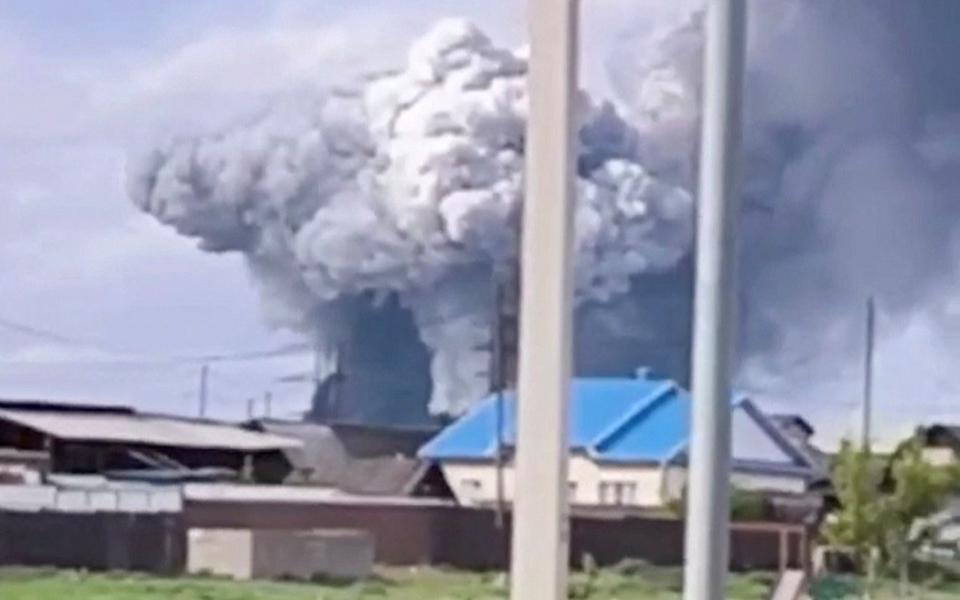
Smoke rises following a drone attack on a military unit in the Sredny settlement – Governor of Irkutsk Region/Reuters
The damage was not just symbolic. Russia’s long-range strike capabilities have been degraded. A significant financial cost has been incurred. It is possible that Ukraine has inflicted material damage of more than £1 billion.
Even in a country where public dissent is not tolerated, such a debacle may well provoke recriminations within the armed forces and Russia’s influential military bloggers.
Granted, Russia still has dozens of strategic bombers. But they may now have to be moved even farther east. Even then, the nagging suspicion will remain that nowhere in Russia is truly safe.
That fear will be felt acutely in the the civilian populations of Siberia and Russia’s far north – regions that, until now, seemed far removed from the conflict. The war has arrived at their doorstep.
Broaden your horizons with award-winning British journalism. Try The Telegraph free for 1 month with unlimited access to our award-winning website, exclusive app, money-saving offers and more.



